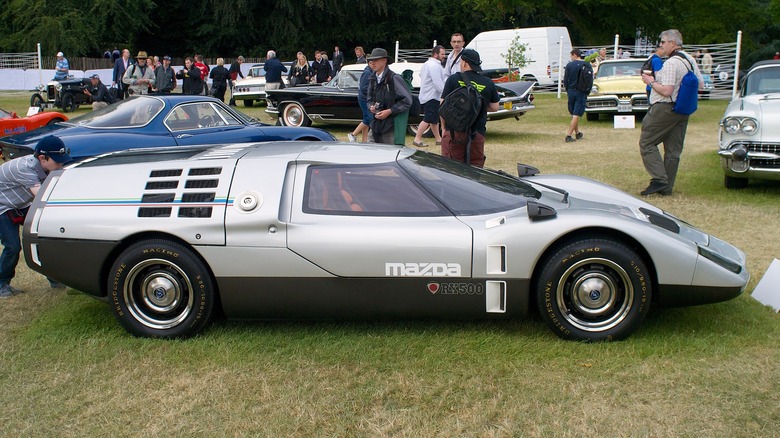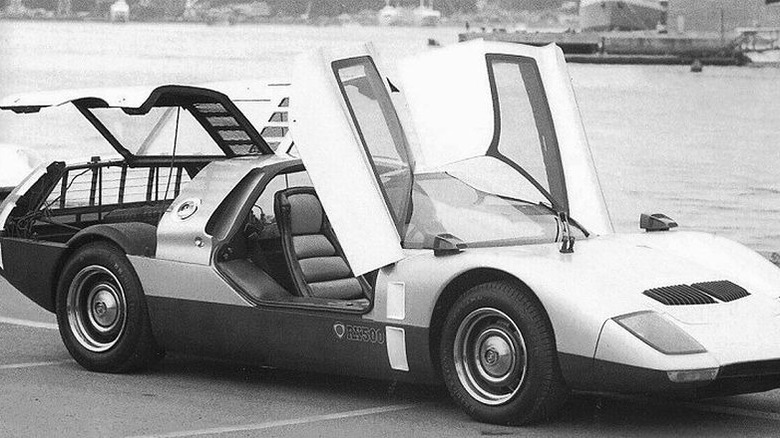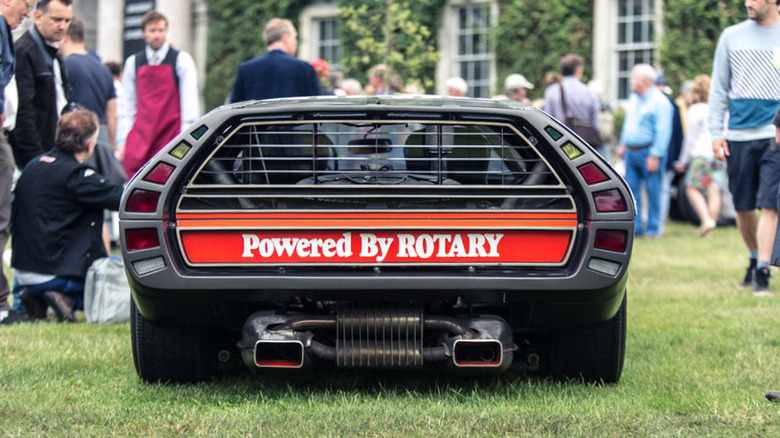The Forgotten Mazda Concept Car With Color-Changing Tail Lights
The origins of Mazda stretch back to 1920 when Jujiro Matsuda started a business making cork (not cars) in Hiroshima, Japan. 10 years later, the name of the company — Toyo Cork Kogyo — was changed to Mazda Motor Corporation in honor of Ahura Mazda, the god of harmony, intelligence, and wisdom. In 1931, the company released its first vehicle: a three-wheeled "truck" (it was really a motorcycle) called the Mazda GO.
Nine years later (1940), Mazda created its first four-wheeled car concept with a small saloon-style four-seater (via Mazda). Then World War II reared its ugly head, and the company suspended all vehicle production and switched to making rifles for Japanese soldiers. On August 6, 1945, the 9,000-pound atomic bomb named "Little Boy" dropped on Hiroshima; killing approximately 80,000 people in the initial blast, with tens of thousands more dying from the subsequent radiation fallout.
This unimaginably tragic event shifted Mazda's focus, and it began to incorporate the people of Hiroshima — their bravery, persistence, and spirit — into its mission statement. Some of the still intact areas of the facility were used as field hospitals, but by the end of 1945, it was once again making commercial vehicles and by 1949, was exporting the Mazda GOs (via Mazda). This pivotal historical moment marked the beginning of Mazda's emergence as a worldwide car manufacturer.
Mazda rolled the dice and took a chance
Jump ahead to the mid-1960s. After keeping a keen eye on the global market, Mazda wanted to build a midship car as an heir apparent to its popular flagship — the Mazda Cosmo Sport 110S. According to designer Shigenori Fukuda, the company was using a principle known as "offline 5:5" at the time, which allowed its designers to come up with concepts that only had a 50% chance of actually working (per Pen).
Fukuda recalls the beginning of the RX-500 concept was informal at first. Five other "like-minded" individuals teamed up and began working on the project after hours. Each produced their own design, with Fukuda's ultimately being chosen because it had "the least air resistance." After some tweaks, Fukada's initial Kammback design morphed into a 3-in-1 concept where the vehicle could also become a racer by swapping out the rear cowl and adding a rear wing to the coupe, or be made into — oddly enough — a wagon (via Pen).
In January of 1969, they displayed a clay model of the car and publicly announced the RX-500 to the general public. The response was so great they were given the green light to make a complete concept version. But it needed to be built in time to show off at the Tokyo Motor Show in November of the following year (1970), during the company's 50-year Golden Jubilee celebration (via Pen).
The RX-500 was a blast into the future
Fukuda wanted to merge a race car with an airplane, and even took inspiration from Stanley Kubrick's "2001: A Space Odyssey" for its unique Kammback-style rear end. "I wanted to make the car as unlike an automobile as I could," said Fukuda (via Pen).
The coupe's body was comprised entirely of ultralight plastic panels atop a steel tube space frame, and in doing so, the car only weighed 1,873 pounds. It was powered by a 491cc Wankel rotary engine mounted between the driver and rear axle (midship), banged out 247 horsepower, and could rev up to an astonishing 15,000 RPM.
Aside from the large "afterburner" looking exhaust package on the back, the tail lights also had an intriguing feature that could be useful on today's cars. Green lights would illuminate when it was running at speed, but the tail lights would turn yellow when the vehicle began to break and go completely red when it came to a stop (via Pen). Between the wrap-around windowed canopy, air intakes/outlets along either side of the body, and the rear "afterburners," everything about the look of this thing screamed futuristic.
Alas, it never made it into production. Mazda couldn't figure out how to get it small enough for mass production (it was much larger than the Cosmo), and then the global oil crisis hit in 1973, stalling Mazda's midship on the launch pad (via Pen). It was briefly resurrected when a Hiroshima museum restored it, and it made a few appearances at the occasional car show. However, it lives on as a 1:59 scale Matchbox car and shows up as a drivable car in Sony's Gran Turismo 6 for the PlayStation 3.


